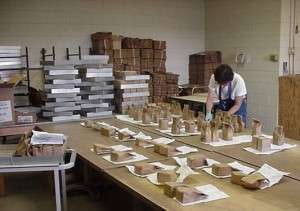Soil testing is like eating right and exercising. Though clearly a good idea, it’s not something that happens as often as it probably should.
Agronomists and other plant scientists stress that a given soil’s fertility fluctuates throughout the growing season, so when spring comes around, it’s a good idea to test it. Nutrients that were present early last summer may well have been removed by virtue of plant growth.
 Soil samples are organized and logged in with lab numbers after they’re received by Clemson University’s Agricultural Service Laboratory.
Soil samples are organized and logged in with lab numbers after they’re received by Clemson University’s Agricultural Service Laboratory.Photo: Clemson University
For landscape contractors, the need for a soil test is especially pressing when taking on a new client – even one next door to a longstanding customer, according to University of Florida researchers. After all, you may know precisely what fertilizer and herbicide were used on the longtime client’s property, but the nearby soil is likely to test much differently in terms of available nutrients, acidity (pH) and the like.
Still, many landscape professionals prefer to rely on years of experience in their areas of operation, rather than soil tests, in determining the kinds of fertilizers they’ll use this spring.
For Mark Geary, branch manager with Spring-Green Lawn Care Corp. in Plainfield, Illinois, one of the country’s largest landscape contractors, soil tests are a good tool when necessary, but Geary says he seldom has them done.
“In our area,” he said, “we see soil conditions that are pretty similar. Now, at our branches further south, where the soil is sandy, it could be more difficult.”
Geary said soil tests are reserved for when a problem crops up – that is, plants that aren’t thriving as they should. In those instances, he said, Spring-Green will take soil samples and drop them off at SiteOne Landscape Supply, which will have them tested.
For some landscapers, however, soil testing is routine – both to ensure plants thrive and to demonstrate to clients that the right steps are being taken at every step in their project.
At Greenscapes of Southwest Florida in Naples, another of the country’s largest landscape contractors, company President Linda Rae Nelson says soil tests are conducted at least once a year and often twice.
In Florida, she said, weather events can have significant impacts on soil – primarily in terms of water, of course, but also the chemicals that water can bring in or wash away.
“Nature corrects the bulk of it over time,” she said, but Greenscapes conducts regular soil tests rather than waiting for nature to take its course.
“That science is beneficial in two ways,” Nelson said. First is by making sure clients’ grass, flowers, shrubs and trees continue to thrive. And secondly, if problems do occur, having conducted soil tests and treated the property accordingly helps demonstrate that proper due diligence was exercised.
Regularly testing the soil and making changes to individual customers’ treatment plans based on the results also “impresses the clients,” Nelson said. “They love to see that level of professionalism and stewardship.”
She said Greenscapes of Southwest Florida does soil testing near the end of the feed (or fertilization) cycle: in summer and again in late fall. “Of course, if you sample too close to the feed, the numbers are going to be exceptionally high.”
In the end, the best reasons for soil testing are pretty straightforward. Because it’s the best way to determine how much lime and fertilizer is needed for optimal growth, it can save you money by preventing you from using too much of either. The testing itself is inexpensive. And while gathering the soil samples is an important process to get right, it’s also a simple one.
For Dr. Oscar Ruiz of Waypoint Analytical, a laboratory that conducts numerous kinds of soil analyses, taking the time to obtain soil tests is always a good idea.
“I think most landscapers do it if they want to make sure what they plant is going to get established,” Ruiz said.
And while tests will occasionally show that soil has all it needs to foster that growth, “it’s usually the other way around,” he said. “You find there’s a lack of nutrients or the pH is off.”
Fixing that problem ahead of time may not guarantee a project’s success, but it could go a long way toward preventing costly call-backs.










